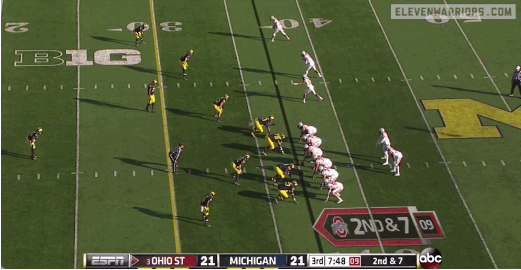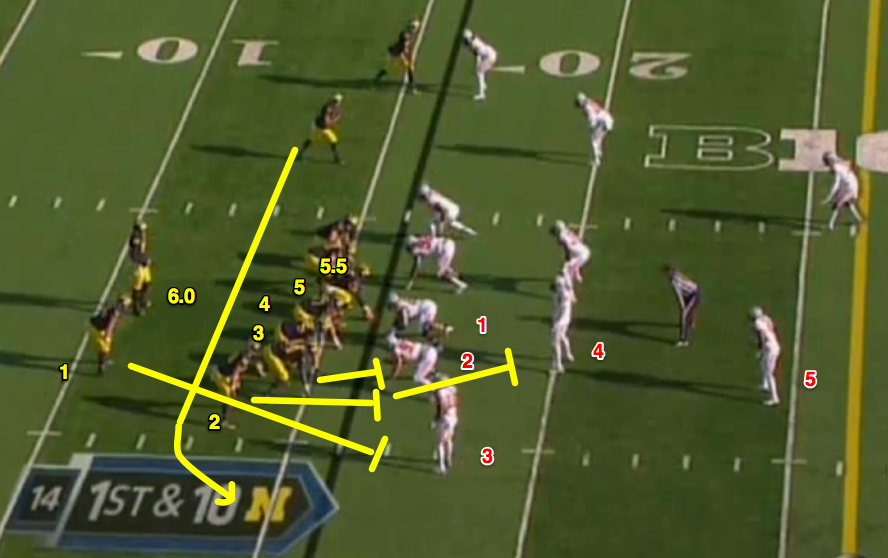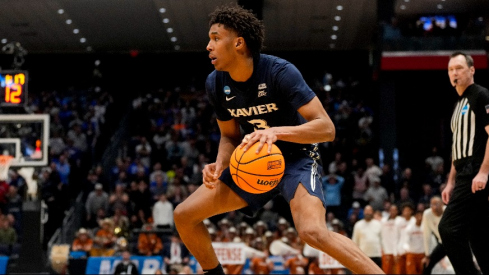
Ohio State's 42-41 win against Michigan was a game that emphasized the strengths and weaknesses of the 2013 Buckeyes.
The Buckeye offense was again near dominant even with an inconsistent passing game. Urban Meyer and Tom Herman quickly adjusted to Michigan's field pressure, and once they did so, the Buckeyes demonstrated why they have one of the best run offenses in recent memory.
The Ohio State defense, by contrast, reverted to old habits. Michigan outflanked the Buckeyes to the boundary and Ohio State defenders all too often played undisciplined, failing to stay home against constraint plays and missing too many tackles.
Below I address the Ohio State offensive game plan and the defensive breakdowns in both scheme and execution.*
Playing games
Michigan Defensive Coordinator Greg Mattison's game plan was similar to his 2012 version. The Wolverines played a 4-3 field under and altered their coverage depending upon Carlos Hyde’s alignment. If Hyde was to the boundary, Michigan often played a variation of cover 4. If Hyde was to the field the Wolverines utilized a single high safety look.
The purpose was to defend the Ohio State run game without leaving themselves vulnerable to wide receiver screens. Mattison wanted to ensure that Michigan covered the Buckeye wide receivers to Hyde’s side of the field, because this is the side that Braxton Miller reads for packaged screen passes.
To do so, Mattison played games with the field Sam linebacker. The Sam would not cheat into the gray area, but instead aligned head up over the receiver, hoping to prevent the Buckeyes from dialing up easy screens. But the Sam would often crash down at the snap to account for Miller on tight zone read, allowing the defensive end to play the zone run.

The Wolverines made several early tackles where Miller read the defensive end crashing down, only to be met by a blitzing Sam linebacker.
Hitting the Right Chords
But Meyer and Herman quickly adjusted. To run inside zone, the Buckeyes aligned Hyde to the tight end side and ran inside zone to the open end. This allowed Jeff Heuerman to base block the outside defender. Michigan's field pressure was eliminated from the play by the Buckeyes reading the opposite side.

The Buckeyes next dialed up tight zone bash with jet sweep towards the Sam linebacker. The slot received seal the crashing 'backer, allowing the Buckeyes to get outside.
Finally, Meyer and Herman attacked the front side of the Wolverine defense with inverted veer. Michigan never had an answer for Miller keeping on the play, as the Wolverines did not have the bodies to defend the backside edge, maintain a deep safety and cover the Ohio State wide receivers.

Homer Smith once referred to Tom Osborne as playing a “medley of tunes” with the Nebraska run offense during their 1990’s heyday. No matter what a defense may do, Osborne had an answer.
The 2013 Ohio State run offense under Meyer and Herman is reaching that level. The Buckeye offense begins with a stellar offensive line, which received a crucial contribution from Pat Eflein at right guard following Marcus Hall’s departure.
Ohio State then has Miller and Hyde, two of the best runners in college football. With Miller and Hyde playing off each other, Meyer and Herman can utilize any number of reads and direct runs to counter whatever method a defense seeks to apply additional defenders against the run game.

So the Buckeyes are able to run the football game in and game out, even though teams devote edge linebackers and safeties to stop the run.
Hobbling Along
The Buckeye run game was all the more impressive because the Ohio State passing game was sporadic. The deep crossing route was open throughout. But Miller missed open receivers or was inaccurate early. Perhaps because of this, Meyer and Herman devolved to using the Buckeye passing game as largely a vertical change-up to keep Michigan from stacking against the run game.
Miller made several nice throws, including two seam routes to Heuerman. Miller's scrambling ability – such as on Ohio State's third touchdown – are also important positive plays out of the passing game.
Yet Miller seemed jittery early, resulting in his elbow dropping and several throws sailing. Miller's confidence as a passer seems highly dependent on how he begins the game. He also did not receive a lot of help from his wide receivers, including drops, a covered-up receiver that negated a big throw to Corey Brown, and Evan Spencer stepping out of bounds when he was wide open.
The Buckeye offense cannoty operate on all cylinders, however, without a fully functioning pass game. In particular, the biggest drive killer against Michigan was negative plays, as Miller held the ball too long several times and took sacks. When the Buckeyes get behind schedule it becomes more difficult to fall back upon their running game.
The Buckeye passing game may get an assist next week, however, by playing in a dome. The Buckeyes must reclaim their mid-range passing game. This is both an issue of scheme and execution. Herman cannot devolve to only calling vertical routes. For his part, Miller must be willing to pull the trigger on open throws and not revert to throwing deep when in doubt.
The Song Remains the Same
The Buckeye defense, by contrast, took a significant step back in allowing over 600 yards and 41 points. As these things often go, the breakdowns had both a schematic and execution element. Beginning with scheme, Ohio State again yielded the same type of plays that have bedeviled them as a defense for two seasons.
Specifically, Michigan entered the game knowing they could not line up and run the football at Ohio State. But what they could do was attack areas of weakness. Those two areas were a) the underneath hook to curl zone against Ohio State’s zone defense, and b) by outflanking the Buckeye defense to the boundary and running to the edge, particularly with misdirection.
The former has both a scheme and execution element. Even when playing zone, defenders cannot sit still. They must pattern match and cover receivers. Yet Ohio State’s underneath defenders – whether it is teaching, execution of both – cannot grasp how to get proper zone depth and cover receivers entering their zone.
The latter issue of boundary defense is more systematic. Like Iowa this year or Cal two years ago, Michigan was able to get easy yards by aligning their blocking strength to the boundary and running to the edge. By aligning to the defensive front to the field and failing to adjust, the Buckeyes are outflanked before the snap. For instance, Michigan picked up easy yards by putting their tight end and wing to the boundary and running touch passes to Jeremy Gallon.

In fact, Michigan went so far as to put their tackle to the boundary to run speed option and the Buckeyes still did not adjust. Michigan has previously shown this look (with limited success) this season, but the Buckeyes did not seem to expect it.

In the second half Fickell increasingly utilized quarter-quarter-half coverage to put Roby in force support to the boundary. This limited Michigan's boundary run game and Ohio State was able to slow the Wolverines in the second and third quarters.
Yet in some ways it was too little too late. The two issues of underneath zone defense and boundary support continue to bedevil the Buckeyes, providing opposing offenses easy yards and completions.
Chickens with their Heads Cut Off
Ohio State's execution was equally at fault. Specifically, the Buckeye defenders looked undisciplined. The Buckeye backside defenders never stayed home, providing Michigan ample opportunities to run throwback screens. The Wolverines particularly abused Joey Bosa with such misdirection plays, as he never failed to over pursue Gardner.
The Buckeyes’ field secondary players – namely Doran Grant and Corey Brown – failed to properly diagnose the play and take aggressive angles to the football. When a play such as a throwback or tunnel screen is coming, the secondary defender needs to flow downhill and, at worst, dive at the lineman’s legs and made a pile. But Ohio State defenders all too often caught Michigan linemen down field. And they were not going to have a lot of success doing so against Taylor Lewan.

Bradley Roby and Grant did a much better job triggering against screens as the game progressed. But Brown is often passive and unable or unwilling to aggressively play downhill. So even if the corners forced the football back inside, the Buckeye defense lacked any pursuit, as Brown did not play inside-out and Bosa ran himself out of the play.
Heads Up
Buckeye defenders were also undisciplined in their tackling, representing a significant step backward. Would be tacklers frequently failed to break down and/or attempted to tackle with their head down, leading to missed tackles. The Buckeyes only stopped the Michigan passing game when they pressured Gardner. But Buckeye defenders would get in the backfield only to miss tackles, inevitably leading to completions off Gardner scrambles.
Making matters worse, the Buckeye defense again became short handed when Curtis Grant left because of his ankle injury. Ohio State lacks a fourth linebacker; the defense cannot function with Cam Williams at Mike.
To minimize the issue once Grant left, Fickell increasingly used the Buckeyes' 3-3-5 bear front that in effect makes Noah Spence an additional linebacker. But iff Grant is unable to play moving forward, Ohio State must come up with another plan against Michigan State, whether it be staying in nickel or bringing Williams in at Sam (the position he plays) and keeping Perry at Mike. The latter seems a more sensible plan, as it makes little sense to ask a young linebacker like Perry to play two positions – Mike in nickel and Sam in base defense.
Only One Way to Go
The only positive takeaway is that the Ohio State defense has played better. Ryan Shazier stated that the Buckeye defenders were over hyped heading into the game, and the Buckeye defense in fact played like it. It is always dangerous to psychoanalyze, but it appeared that to avoid complacency in a game everyone was expecting them to win, the Buckeyes went the opposite way and turned it into a personal grudge match rather than playing football.
The Michigan offense, in particular Gardner, deserved credit for playing one of their best games of the season. But the Buckeye defense’s undisciplined play was like gasoline on a fire. Without Christian Bryant, the Buckeye defense does not seem to have someone who can settle people down and diagnose what the opponent is doing.
And ultimately, someone needs to step up and make a play when the game is on the line. It appeared that the Buckeye defense settled down in the second and third quarter, as Fickell utilized more twisting and blitzing. But the Buckeye defense then failed to get off the field against the Michigan passing game in the fourth. Tyvis Powell ultimately made a paly on the two point conversion, but Bradley Roby and CJ Barnett frittered away such opportunities by dropping easy interceptions.
The 2013 Buckeyes will always be a team led by its offense and, at this point, it is doubtful that Ohio State’s linebackers and safeties can consistently play the pass. But the Ohio State defense will play better simply by playing assignment football and tackling, both of which they did far better against Indiana then they did against Michigan.
Ohio State must now regroup and focus upon Michigan State for the Big Ten championship. On Thursday I will analyze the Spartans offense and defense and how the Buckeyes may match-up.
*I am devoting today's column to reviewing the offense and defense so that I can analyze the Spartans Thursday in anticipation of the Big Ten Championship game.

